Inkjet vs. Laser Printers - Which is Best For You?
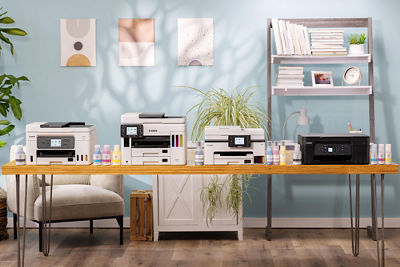
As the digital era and evolving work-from-home policies transform the modern office, reliable technologies like the printer are still critical to business workflows and functions. An onsite printer isn’t just a nice-to-have. For many businesses and their team members, it’s a must, both for long-term projects and last-minute printing needs.
The printers available today are as versatile as any business’s needs. Single-function printers focus on one task and one task alone, while all-in-one printers can handle the whole kit and caboodle: printing, copying, scanning and with some, even faxing.
Whatever you choose, there’s one important question you’ll have to ask yourself: inkjet vs. laser printer?
Read on for the benefits and downsides of inkjet printing and laser printing, plus some links to some top Canon inkjet and laser printing picks.
Inkjet Printers
An inkjet printer, true to its name, uses ink to print documents and images from a desktop or laptop computer or from a mobile device. It works by spraying tiny droplets of ink from an ink cartridge onto a page. Inkjet printers are often found in small offices, home offices, artist and photography studios and are used by students, individuals and families.
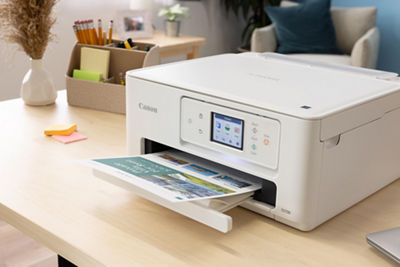
Inkjet Printer Benefits
Depending on your needs and budget, an inkjet printer could be an excellent addition to your office or home. Some of the benefits include:
- High-quality printing. An inkjet printer can help put the finishing touches on beautiful creative projects and photo projects, as well as documents and reports.
- Affordability. Inkjet printers can be quite inexpensive. The price makes this option a great fit for many home offices and small businesses, and also for students and families.
- Versatility. An inkjet printer can handle a whole array of printing jobs, including (depending on the printer), printing on photo paper, printing business cards and greeting cards and so much more. If the inkjet printer is an all-in-one, its capabilities also include scanning, copying, and depending on the printer, faxing.
- Size. With their compact size, inkjet printers can easily fit into a small office or a home office.
- Sound. These printers make minimal noise, so you don’t have to worry much about disrupting officemates—or housemates and family members if you work from home.
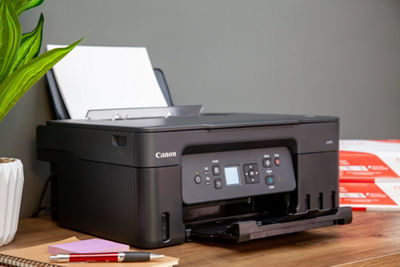
Want to get to know some of the top choices for inkjet printers? Here are two popular offerings from Canon:
|
|
Downsides of Inkjet Printing
While inkjet printers are a perfect match for many people’s needs, it’s important to examine the potential downsides, as well. Depending on the individual, those downsides may include:
- Speed. For a business with higher printing needs, you’ll find a slower printing speed with inkjet vs. laser printers.
- Ink costs. While the prices of inkjet printers can be low, the prices of ink cartridges can be high. However, ink tank printers using bottled ink (as opposed to ink cartridges) with overall lower cost per page. Be sure to do some calculations comparing inkjet costs to laser printers and toner if you expect to print in large quantities.
- Maintenance. Inkjet printers tend to require more maintenance than their laser counterparts, including print head maintenance, which consumes time and ink.
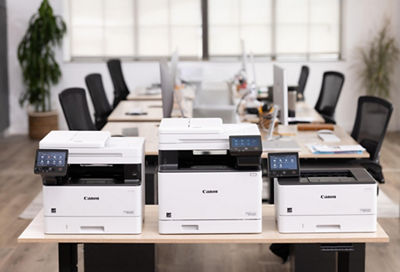
Laser Printers
A laser printer, true to its name, uses a laser and toner to print documents and images from a computer or mobile device. So if you’ve ever wondered, “do laser printers use ink?” the answer is no. The output of the laser printer is known as an “electrostatic image” because, in simple terms, it relies on static electricity to attract toner, which then creates the image that comes out of your printer. Laser printers are often found at businesses and enterprises such as schools that print a high volume of documents. They’re also a popular choice for small businesses and homes that have a fair amount of printing needs and don’t want to deal with inkjet printer maintenance and ink cartridge replacement or ink tank refilling.

Benefits of Laser Printers
If you’re looking for a printer that can produce lots of pages quickly and reliably, a laser printer could be an excellent addition to your office or home. Some of the benefits of laser printing include:
- Speed. As mentioned, people who print in high volumes will notice a big difference in speed when comparing laser vs inkjet printers.
- Cost. People who print at high volumes will get more bang for their buck on a per-page basis with a laser printer, despite the fact that toner cartridges tend to be more expensive than ink.
- Quality. For text-heavy materials and professional-quality documents, in particular, laser printers produce impressively sharp text and graphics.
- Low maintenance needs. Laser printers are known for printing fast, at a low cost per page. In many cases, toner cartridges last longer than ink cartridges, meaning the user has to replace the toner infrequently. In addition, laser printers may require fewer ongoing maintenance procedures compared to inkjet printers.
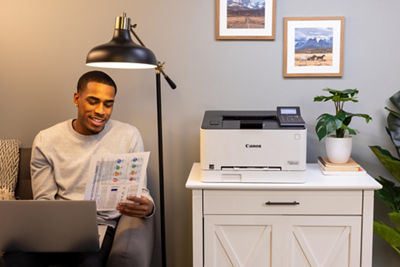
Want to get to know some of the top choices for inkjet printers? Here are two popular offerings from Canon:
|
|
Drawbacks of Laser Printers
While laser printers are an ideal office addition for many workplaces, it’s important to examine the potential downsides, as well. Those may include:
- Cost. The initial purchase price of a laser printer vs. inkjet is often higher. So consumers should consider their printing needs and do some calculations to determine the long-term payoff.
- Limited versatility. Laser printers have some limitations in the kinds of documents they print. If you’re looking to print photos on photo paper or art on fabric, for example, an inkjet printer is a better bet.
- Size. The design of a laser printer tends to be bulkier and heavier than an inkjet printer.
There’s a lot to consider when deciding between an inkjet vs. a laser printer. While these insights are a good jumping-off point, the next step calls for some comparison shopping. Get started today by looking into more Canon home printers and office printers to help you find the perfect printer for your needs.
- Wireless printing and scanning requires a working network with wireless 802.11b/g/n capability, operating at 2.4GHz or 5.0GHz. Wireless performance may vary based on terrain and distance between the printer and wireless network clients.
- Document print speeds are the averages of ESAT in Office Category Test for the default simplex mode, ISO/IEC 24734. Print speed may vary depending on system configuration, interface, software, document complexity, print mode, page coverage, type of paper used etc. See www.usa.canon.com/ipm for additional details.
- Savings amount will vary depending on the monthly plan chosen and does not apply to the Pay Per Print plan. The savings claim applies to the monthly print plans available and is based on the cost per print calculated on the page yield of 400 Black / 300 Color pages per ink cartridge set and cost of $58.99 for a value pack of PG-260(XL) and CL-261(XL), the page yield of 300 Black / 300 Color pages per ink cartridge set and cost of $55.99 for a value pack of PG-275(XL) and CL-276(XL) and the page yield of 400 Black / 400 Color pages per ink cartridge set and cost of $75.99 for a value pack of PG-285(XL) and CL-286(XL) ink cartridges (using Canon Online Store prices as of October 2023). Actual page yield and cost per print will vary significantly based on content printed and other factors. Page yield is an estimated value based on Canon individual testing method using ISO/IEC 24712 test chart and continuous printing simulation with full set of ink cartridges after initial setup. See https://www.usa.canon.com/internet/portal/us/home/products/groups/page-yield for additional information regarding page yields.
- As an ENERGY STAR® Partner, Canon U.S.A., Inc. has certified this printer as meeting the ENERGY STAR energy efficiency criteria through an EPA-recognized certification body.
- Warranty programs are subject to certain conditions and restrictions. See www.usa.canon.com/support for details.
- Page yield of included ink bottles used for initial setup is lower than the replacement ink bottles, as a certain amount of ink is consumed to fill into the print head during setup (charging the print head initially). Page yield is the estimated value based on Canon individual test method using the ISO/IEC 24712 chart and continuous printing simulation with the replacement ink bottles after initial setup. Page yield of color inks is an average yield of cyan, magenta and yellow inks combined. Page yield varies significantly depending on content printed, ink levels maintained in all four reservoirs, and other factors. Up to 6,000 (black)/7,700 (color) printed page yields are approximate using `default printing mode’, up to 8,300 (black)/7,700 (color) printed page yields are approximate using `economy printing mode’ via Windows/Mac OS driver or printer copy setting, based off document pages printed. A full set of MegaTank GI-21 ink bottles (pigment black, cyan, magenta, yellow) is equivalent to 30 each standard capacity Black (PG-260) and Color (CL-261, composed of cyan, magenta and yellow) ink cartridges sold individually based on print yield. Ink value savings based on MSRP (USD) of stated equivalent ink cartridges as of February 2023.
- Wireless printing requires a working network with wireless 802.11b/g or 802.11n capability. Wireless performance may vary based on terrain and distance between the printer and wireless network clients.
- Print speed is based on internal testing. Print speed may vary, depending on the number of copies selected as well as the settings for size, type, and orientation of paper.
- Warranty program is subject to certain conditions and restrictions. See warranty card for details.


